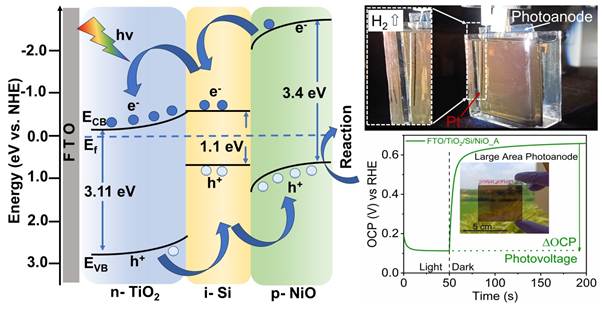In a groundbreaking development that could redefine the future of clean energy, scientists in India have successfully created a scalable, next-generation device that generates green hydrogen using only solar energy. This innovation not only eliminates dependence on fossil fuels but also uses abundant and affordable materials, addressing a longstanding challenge in the pursuit of carbon-free energy.
Developed by researchers from the Centre for Nano and Soft Matter Sciences (CeNS) in Bengaluru—an autonomous institute under the Department of Science and Technology (DST)—the new device splits water molecules into hydrogen and oxygen using solar power alone.
It represents a significant step forward in the global mission to decarbonise energy systems across industries, transport, and infrastructure.
Game-changer in Green Hydrogen production
Green hydrogen is widely hailed as the fuel of the future. It emits zero greenhouse gases when burned and can be used in sectors ranging from power generation and chemical manufacturing to aviation and long-haul transportation. However, the high cost and technical limitations of producing it at scale have remained major roadblocks.
That may now be changing.
Led by Dr. Ashutosh K. Singh, the CeNS research team engineered a silicon-based photoanode—the core component of the device—using a novel n-i-p heterojunction architecture. This design comprises three layers: n-type TiO₂; Intrinsic (undoped) silicon (Si); p-type NiO.
Each layer plays a crucial role in efficiently absorbing sunlight, separating electrical charges, and transporting them to initiate the water-splitting reaction.
The team used magnetron sputtering, an industry-ready thin-film deposition method, to layer the semiconductors with high precision and reproducibility. This approach ensures that the device is not only efficient in the lab but also scalable for commercial manufacturing.
Exceptional performance and durability
The prototype device achieved a surface photovoltage of 600 millivolts (mV) and an onset potential as low as 0.11 V versus the reversible hydrogen electrode (RHE), making it remarkably efficient in converting solar energy into chemical energy. These metrics indicate a lower energy threshold to start hydrogen generation and a stronger ability to harness sunlight effectively.
In long-term operational tests, the device ran for over 10 continuous hours in alkaline conditions, exhibiting only a 4 per cent drop in performance—a level of durability rarely seen in silicon-based photoelectrochemical (PEC) systems. Even more encouragingly, the technology maintained its efficiency when scaled up to a 25 square centimeter (cm²) photoanode, demonstrating its potential for industrial-scale applications.
“By selecting smart materials and combining them into a heterostructure, we have created a device that not only boosts performance but can also be produced on a large scale,” said Dr. Singh, the project lead. “This brings us one step closer to affordable, large-scale solar-to-hydrogen energy systems.”
Innovation meets scalability
What sets this development apart is its attention to scalability and cost-effectiveness. Traditional methods for green hydrogen production often rely on rare or expensive materials such as platinum or iridium, or on complex fabrication processes. In contrast, the CeNS device uses earth-abundant materials and an industry-standard fabrication method, offering a practical pathway to mass deployment.

A schematic illustration provided by the team shows the charge transfer pathways within the n-i-p heterojunction photoanode. Accompanying images highlight the large-area device generating hydrogen directly from sunlight and its impressive surface photovoltage response, underlining the feasibility and robustness of the approach.
Broader implications for India and beyond
This innovation comes at a critical time as India intensifies its commitment to clean energy and climate action. The National Green Hydrogen Mission, launched by the Indian government, aims to make India a global hub for green hydrogen production and export. Advances like the one achieved by the CeNS team could serve as a cornerstone for realising these ambitions.
Moreover, this technology could have transformative implications globally—providing an affordable and sustainable solution for countries seeking to transition to net-zero energy systems.
So far, the research findings have been published in the prestigious Journal of Materials Chemistry A, under the Royal Society of Chemistry. While the current device is already demonstrating remarkable performance, the researchers are optimistic about further advancements.
With continued refinement and industry collaboration, the CeNS team envisions this technology powering everything from residential hydrogen fuel cells to large-scale industrial applications, all fuelled by the sun.




